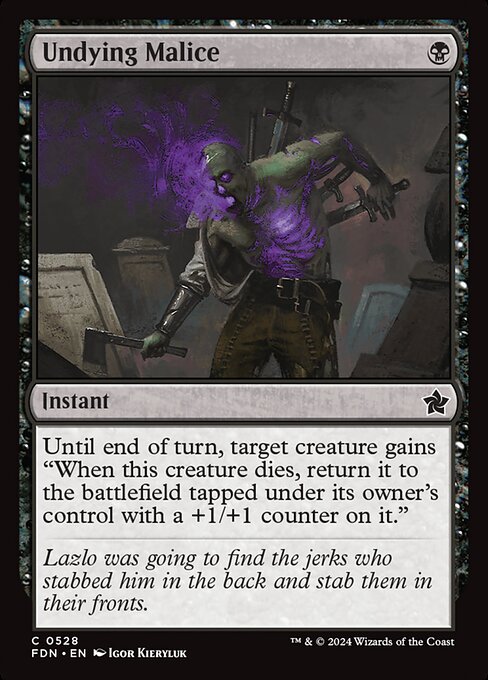
Image courtesy of Scryfall.com
Un-Set Art Speaks: A Case Study in Narrative Through Visuals
When we talk about Magic: The Gathering, the cards often feel like tiny windows into bigger stories. Some doors swing open with epic mythologies and tenacious plans; others open with a wink, inviting you to read the scene as if the illustration itself were whispering a joke across the battlefield. In the realm of Un-sets and their kin, art becomes a portable storyteller—one that nudges you toward a feeling, a character, or a moment longer than the words on the card ever could. The piece from Foundations, Undying Malice, gives us a perfect lens to examine how a single frame can carry a narrative that echoes beyond the text on the card. 🧙♂️🔥💎
Designed as a one-mana Black instant, the spell’s words are lean, but the image that accompanies them is a carnival of character. The illustration—by Igor Kieryluk—shows a figure whose smirk suggests the edge of mischief and the promise of a plan succeeding just a breath sooner than you expect. The flavor text, “Lazlo was going to find the jerks who stabbed him in the back and stab them in their fronts,” reinforces this mood: a stubborn, stubborn resilience that wants justice even if the method is unorthodox. In Un-sets, art and flavor text often collide to remind you that the narrative isn’t just in the card’s rules—it’s in the attitude of the art itself. 🎨⚔️
“Lazlo was going to find the jerks who stabbed him in the back and stab them in their fronts.”
What the card does on the table
Undying Malice costs {B} and is classified as an Instant. On resolution, it provides a temporary aura of resilience to a chosen creature: Until end of turn, that creature gains a triggered ability—“When this creature dies, return it to the battlefield tapped under its owner’s control with a +1/+1 counter on it.” In practical terms, you tuck a little promise of revival into your opponent’s headspace. If your creature takes a lethal hit, you’ve got a back-pocket plan to come back with a bigger body the next time it breathes, which can swing races, block turns, or bait combat tricks. The text lands in a way that feels almost like a wink to old-school black strategies—keep a threat around, then reanimate it stronger than before. Its rarity is common, so it’s a budget-friendly brute that still nudges the storytelling power of the game. 🧙♂️
From a design perspective, the card leans into black’s core themes—recursion, resilience, and the stubbornness of death’s boundary. The return-to-battlefield timing, tapped, with a +1/+1 counter, hints at a “undying” vibe even if the word Undying Malice isn’t using a keyword here. It’s a flavor of the undead ethos without overwhelming the board state, which makes it friendly for Limited play while still offering a hook for casual Commander builds. Kieryluk’s art—paired with the crisp, compact wording—creates a compact narrative beat: a rival who clamps down on fate and gets a second chance to deliver a sharper punch. The result is a card that feels like a micro-story about defiance and second chances. 🔪🧭
Art as narrative—what the image adds to the encounter
In Un-sets and their broader kin, the art often acts as a narrator that lets you overhear the subtext of the text. Undying Malice demonstrates this beautifully: the card’s art sets the stage for a moment of cunning followed by a dramatic revival. The undead nuance, the gleam of the blade, and the character’s posture invite you to imagine Lazlo’s backstory—the betrayal, the plan, and the moment when the plan pivots toward a second life for a fallen ally. The image becomes a storytelling device that complements the mechanical card text, turning a single instant into a mini-saga you can reference during a game. It’s art-as-scene-setting, art-as-character-building, and—most importantly—art-as-anticipation. 💫
Beyond the Un-set angle, this piece reinforces a broader truth about MTG: the best narrative moments often live at the intersection of clever word choice and evocative illustration. The flavor text anchors the humor, but the art and the revival mechanic anchor the stakes. Together, they invite players to imagine a broader mythos for a single creature and the clever genius who refuses to let it stay dead. That’s the kind of storytelling that keeps the hobby feeling fresh, even when you’re revisiting a classic core-set frame. 🔥🎲
Deck-building whispers and practical use
If you’re assembling a budget-friendly black toolbox, Undying Malice is a tempting inclusion. Its low mana cost makes it easy to fit into early turns, and its effect scales with how you leverage your graveyard and sacrifice themes. In a deck that loves to reanimate or re-trigger death events, the +1/+1 counter can turn a modest body into a threat that outlasts what your opponent expects. In multiplayer formats like Commander, a single mana to potentially recur a key creature can swing combat or clog an opponent’s plans for a turn or two—enough to tilt the game in your favor or at least buy a little time. It’s a reminder that even a small, common card can contribute meaningful, story-forward value when paired with the right window of opportunity. 🧭⚔️
And for fans who adore the confluence of art and gameplay, the Foundations reprint invites a tactile joy: nonfoil rarity, a compact frame, and a striking piece by Kieryluk that still feels fresh and mischievous in today’s table. It’s a small, accessible portal into how art shapes perception, mood, and strategy in this beloved game. If you’re curious about similar visuals, you might explore how other cards in the Foundations cycle balance utility with storytelling—a core pillar of MTG’s enduring charm. 🧙♂️💎
Neon Phone Stand for Smartphones — Two Piece Desk Decor & TravelMore from our network
- https://blog.rusty-articles.xyz/blog/post/building-synergy-with-koga-support-pokemon-deck-strategies/
- https://blog.rusty-articles.xyz/blog/post/elevate-everyday-life-with-neon-magsafe-wallet-case-and-card-holder/
- https://blog.zero-static.xyz/blog/post/mastering-vraskas-fall-timing-and-stacks-in-mtg/
- https://blog.zero-static.xyz/blog/post/dedicated-martyr-unraveling-the-illustrators-mtg-card-art-legacy/
- https://blog.digital-vault.xyz/blog/post/pearl-shard-visualized-a-data-driven-mtg-card-breakdown/